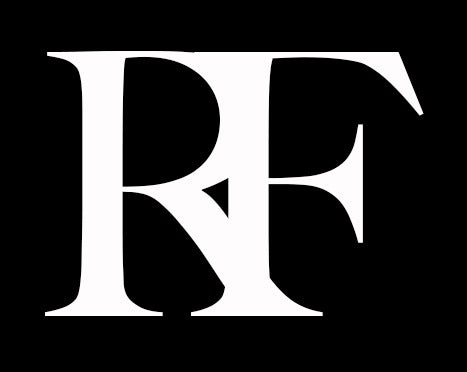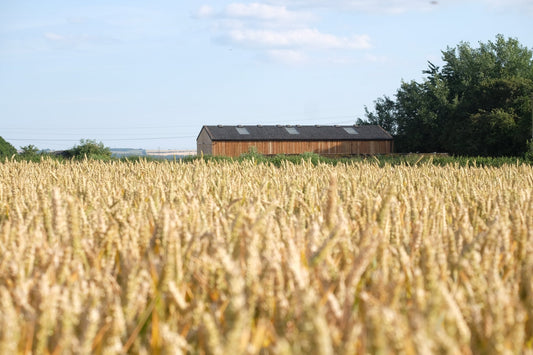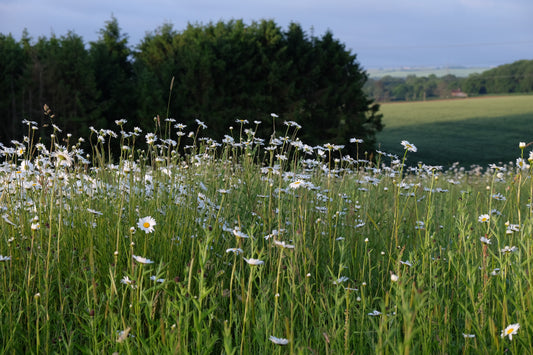Wildlife
Bird Surveys
December 2022
20 Lapwings spotted foraging amongst the sheep on 15 acre and Lower Veniss. A return to rotations, spring sown crops and removal of agrochemicals is encouraging these declining bird species to return. Hopefully we will see some nesting before April.
November 2022
We did not encounter any big finch/bunting flocks, but it was nice to see plenty of Skylarks and Yellowhammers. Full list of birds seen – Carrion Crow, Woodpigeon, Goldfinch, Herring Gull, Robin, Blackbird, Stonechat (2), Rook, Buzzard, Skylark, Pheasant, Song Thrush, Blue Tit, Wren, Dunnock, Yellowhammer, Linnet, Meadow Pipit, Pied Wagtail, Mistle Thrush, Jackdaw, Moorhen, Mallard, Great Spotted Woodpecker, Long-tailed Tit, Kestrel, Stock Dove and Jay (28 species).
June 2022
Another lovely morning to be out on the farm. As would be expected, things are starting to quieten down, but still had 32 species. There were plenty of Skylark around – probably including some young birds. The mapped farmland birds were Skylark (24), Yellowhammer (8), Linnet (3), Kestrel (1) and Whitethroat (6). The other birds were Blackcap, Woodpigeon, Wren, Blackbird, Dunnock, Mediterranean Gull, Carrion Crow, Robin, Pheasant, Chaffinch, Great Tit, Nuthatch, Blue Tit, Jackdaw, Rook, Magpie, Stock Dove, Great Spotted Woodpecker, Song Thrush, Chiffchaff, Swallow, Starling, Collared Dove, Herring Gull, House Sparrow, Mallard and Moorhen. We also saw three Hares and a Roe deer. Although it was a bit early in the day for butterflies, we still saw Meadow Brown, Red Admiral, Small Tortoiseshell, Common Blue and a White species.
May 2022
Nice work spotting the White Tailed Eagle!
Another lovely morning for birding today, plus my best bird (yet!) at Rushmere Farm. We had a Whinchat on the south-west corner of the farm, on the fence line just west of Rushmere Lane. Whinchats are regularly seen on the Downs and coast during autumn passage, but are much scarcer inland in the spring – and much smarter (https://www.wildlifetrusts.org/wildlife-explorer/birds/thrushes-chats-flycatchers-starling-dipper-and-wren/whinchat). Sadly we did not have our camera with us.
We had the following mapped farmland species – Yellowhammer (9), Skylark (14) and Whitethroat (3). Othe birds recorded were – Robin, Collared Dove, Wren, Mediterranean Gull, Blackbird, Herring Gull, Stock Dove, Dunnock, Woodpigeon, Jackdaw, Carrion Crow, Linnet, Starling, Song Thrush, Pheasant, Blackcap, Great Tit, Chiffchaff, Blue Tit, Chaffinch, Black-headed Gull, Rook, Swallow, Magpie, Lesser Black-backed Gull, Mistle Thrush, Jay, House Sparrow, Greenfinch, Mallard, WHINCHAT – total 34 species. We also saw two Roe Deer and three Hare on the Lapwing plot.
April 2022
We had a very pleasant, if a little quiet, walk around the survey route this morning.
The mapped farmland birds were Skylark (17), Linnet (27), Yellowhammer (10) and Red Kite (1). Other birds seen – Blackcap, Wren, Woodpigeon, Blackbird, Pheasant, Collared Dove, Herring Gull, Great Tit, Carrion Crow, Song Thrush, Dunnock, Stock Dove, Great Spotted Woodpecker, Chiffchaff, Chaffinch, Blue Tit, Robin, Green Woodpecker, Rook, Greenfinch, Magpie, House Sparrow, Mallard, Moorhen – total 28 species.
Apart from birds, we saw a Brown Hare, a Rabbit and at least five Roe Deer. We also saw a Pheasant which appeared to be all white! Unfortunately we only saw it in flight - going away from us. Nice to see some cattle….
January 2022
we had a great morning. As you say the field to the west is brilliant for finches and buntings. Big flocks of Chaffinches and Linnets, plus a few less common birds, including Corn Bunting, Reed Bunting and Brambling. Next time, I will bring my scope, so that I can give the flocks a better ‘grilling’.
Full list of 32 species of bird seen – Blackbird, Song Thrush, Woodpigeon, Carrion Crow, Bullfinch, Firecrest, Chaffinch, Magpie, Pheasant, Raven, Great Tit, Meadow Pipit, Brambling, Corn Bunting, Goldfinch, Linnet, Yellowhammer, Buzzard, Stock Dove, Robin, Dunnock, Reed Bunting, Skylark, Starling, Jay, Kestrel, Black-headed Gull, Jackdaw, House Sparrow, Moorhen, Red Kite and Mallard. Also Four Roe Deer.
September 2021
we had a fairly quiet visit this morning, but still managed 26 species. Birds seen – Robin, Carrion Crow, Lesser Black-backed Gull, Kestrel, Woodpigeon, Wren, Collared Dove, Blue Tit, Chiffchaff (probably the only passage birds), Yellowhammer, Linnet, Rook, Jackdaw, Pheasant, Buzzard, Jay, Blackbird, Nuthatch, Herring Gull, Stock Dove, Chaffinch, Dunnock, Long-tailed Tit, Skylark, Goldfinch and Mallard – also two Roe Deer.
We felt the best part of the visit was seeing how well the wildflower/seed mix strips are looking. There were good sized flocks of finches and Yellowhammers using them this morning and presumably numbers will increase as winter arrives. It will be good to see if you can draw in some of the more uncommon seed eaters, such as Brambling, Corn Bunting and maybe even a wandering Tree Sparrow.
July 2021
As is usual in July, things tend to get a bit quiet – total of 28 species. The mapped farmland species were Skylark (13), Yellowhammer (10), Whitethroat (5) and Linnet (2). The other species recorded were – Greenfinch, Blackbird, Mediterranean Gull, Wren, Woodpigeon, Collared Dove, Pheasant, Carrion Crow, Song Thrush, Lesser Black-backed Gull, Swallow, Magpie, Chiffchaff, Blackcap, Rook, Pied Wagtail, Chaffinch, Blue Tit, Feral Pigeon, Robin, Buzzard, Stock Dove, Green Woodpecker and Goldfinch.June 2021
The mapped farmland birds were Skylark (15), Yellowhammer (9), Linnet (1) and Whitethroat (5). Other birds seen this morning were Wren, Jackdaw, Carrion Crow, Woodpigeon, Song Thrush, Blackbird, Kestrel, Pheasant, Red-legged Partridge, Swallow, Great Tit, Magpie, Jay, Chaffinch, Starling, Black-headed Gull, Blue Tit, Nuthatch, Great Spotted Woodpecker, Stock Dove, Long-tailed Tit, Rook, Goldfinch, Pied Wagtail, Robin, Chiffchaff, Blackcap, Greenfinch, Mediterranean Gull, House Sparrow, Collared Dove and Mallard. A total of 36 species. We also saw two Roe Deer and a dead Weasel. I know it will sound bizarre, but we are pretty sure we heard a Peacock calling from somewhere to the east of the farm!May 2021
Of the farmland specific birds, we mapped Linnet (15), Skylark (14), Yellowhammer (6), Whitethroat (5), Kestrel (1). Other species we noted were: Wren, Blackbird, Song Thrush, Goldfinch, Jackdaw, Mediterranean Gull, Pheasant, Woodpigeon, Crow, Robin, Great Tit, Blackcap, Chiffchaff, Robin, Stock Dove, Great Spotted Woodpecker, Red-legged Partridge, Blue Tit, Lesser Black-backed Gull, Black headed Gull, Mallard, Rook, Dunnock, Magpie, Chaffinch, Starling, Swallow, Pied Wagtail, Buzzard. Total of 34 species. Also two Hare and a Roe Deer.We mapped the following farmland birds: Whitethroat (3), Yellowhammer (8), Skylark (12) and Linnet (12). Other birds recorded were : Robin, Wren, Woodpigeon, Collared Dove, Blackbird, Pheasant, Blue Tit, Greenfinch, Mediterranean Gull, Grey Heron, Goldfinch, Swallow, Goldcrest, Great Spotted Woodpecker, Red-legged Partridge, Blackcap, Song Thrush, Rook, Chiffchaff, Black-headed Gull, Dunnock, Stock Dove, Pied Wagtail, Chaffinch, Buzzard, Magpie, Lesser Black-backed Gull, Great Tit, Kestrel and Green Woodpecker. Total of 34 species. Twenty years ago, Mediterranean Gulls would have been a rarity – today we saw 17. Now, they breed along the south coast, with many hundreds in Langstone Harbour. They come inland to feed in fields, so I expect we will see more over the next couple of months as the breeding season progresses. We also saw Brown Hare in three different places and Roe Deer, also in three places. At the north end of the bean field east of Greasteds Copse, we saw a Roe deer which got spooked by a large Alsatian dog. It seemed to be roaming free, as we did not see any people in the area.
April 2021
Of the farmland specific birds, we mapped Linnet (10), Skylark (13), Yellowhammer (6), Whitethroat (1) and a flyover Red Kite. Other species we noted were: Woodpigeon, Blackbird, Pheasant, Wren, Great Spotted Woodpecker, Green Woodpecker, Nuthatch, Carrion Crow, Robin, Collared Dove, Blackcap, Stock Dove, Mistle Thrush, Coal Tit, Blue Tit, Song Thrush, Chiffchaff, Great Tit, Chaffinch, Dunnock, Moorhen, Black-headed Gull, Starling, Greenfinch, Goldfinch. So 30 species in total. We also saw five Brown Hare
April 2024
We did our first survey of the year on Thursday morning (18th). Lovely sunny morning, but a bit of a chilly breeze. It all seems a little slow starting this year, with limited bird song and not many summer migrants around. Of the mapped species, we had 10 Yellowhammers (seven males) and 14 Skylarks. Including these, we had a total of 25 species – Goldfinch, Wren, Chiffchaff, Woodpigeon, Jackdaw, Great Spotted Woodpecker, Blackbird, Green Woodpecker, Carrion Crow, Pheasant, Blue Tit, Rook, Robin, Great Tit, Pied Wagtail, Dunnock, Stock Dove, Mediterranean Gull, Red legged Partridge, Collared Dove, Magpie, Swallow, Blackcap. We also saw Speckled Wood and Red Admiral butterflies.
Dogs & other pets
If you must bring a dog, keep it on a lead, and if you must trespass please do so considerately. We love you and your pets on an individual basis but wildlife fears you both.
All domesticated animals, in particular those that are carnivorous, have an impact on wildlife. We want to give nature a home alongside us, and therefore prioritize the rebuilding of biodiversity above any other activity.
Predatory animals such as dogs are a threat to wildlife, and areas that are visited by dogs will not be visited by wild animals. We have seen the sweetest, cutest of dogs attached to the hind legs of a young deer by their teeth, and just the scent of a dog where a stoat or a hare may wish to reside is enough to move them on.
We are particularly interested in recovering close to extinction populations of ground nesting birds, such as Corn Crake, Grey Partridge, and Corn Bunting. Beautiful and rare species such as these, if successful enough to find a mate and raise young will leave their nests and their young if threatened by a carnivore that has strayed from the footpath.
There are now more dogs in the UK (12.5 million) than there are humans in Scotland, Wales and Northern Ireland put together.
Wildlife decline
Nature is being changed and destroyed by us at a rate unprecedented in history. The 2020 global Living Planet Index shows an average 68% fall in populations of mammals, birds, amphibians, reptiles and fish between 1970 and 2016 (WWF, 2020).
-
Sponsor a Wildflower Meadow
Regular price £47.00 GBPRegular priceUnit price per


